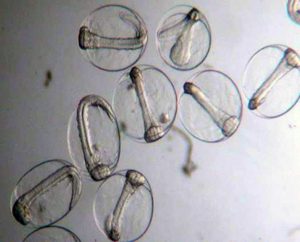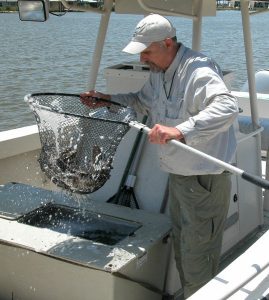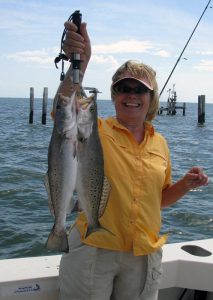The Tiniest Survivors
– March 21, 2013
The bay anchovy is the most important fish you’ve never heard of.
Why? Because greater than 95% of all eggs collected by scientists during summer months in coastal estuaries between the Yucatan and the Chesapeake Bay belong to that species and as adults they serve as the main prey of important recreational species such as speckled trout (spotted sea trout). For this reason GoMRI is funding this study, Defining Ecologically Relevant Sublethal Effects: How do Low Levels of Exposure to Oil and Dispersants Affect Performance and Survival of Larvae of Gulf Nekton?, that will focus on bay anchovy, along with red snapper, spotted sea trout, and blue crab, to determine the effects of oil exposure in the larval stage.
Ed Chesney, PhD., Associate Professor at the Louisiana Universities Marine Consortium (LUMCON), specializes in understanding the recruitment of fish, or which eggs and larvae grow to become adults and why. In a series of lab experiments, he and co-principal investigator Ralph Portier of Louisiana State University will attempt to determine the effects of sublethal exposure to oil and related chemicals, that is, not enough to kill, but enough to do indeterminate damage, on these four species in their larval stages to see if and how it inhibits their development.
The main thing we know about the early life history stages of larvae is that once they begin to feed, that’s all they do. That’s their primary focus in life because they have to grow as quickly as possible in order to survive that early, highly vulnerable stage. So if they’re exposed to a toxicant during that time and it reduces their ability to swim or forage, there will eventually be consequences for that. These experiments are designed to try to look at those effects and determine what they might be. — Ed Chesney, LUMCON
Fish eggs are relatively resistant to oil exposure. That all changes once they hatch. Larval fish populations and the estuaries they live in are incredibly sensitive to any sudden change. Working in the lab at LUMCON, Chesney and Portier plan to create environmental scenarios that mimic the range of chemical exposures larvae might encounter throughout the area affected by a large spill including at the outskirts where oil exposures might be too low to directly kill them. They will observe in the laboratory behaviors of the larval fish and crabs exposed to these conditions: Are they swimming normally? Are they foraging at a rate necessary for survival? Are they able to swim to the surface to swallow air bubbles to help them maintain buoyancy? Has predatory behavior been altered in any way?
They will also look at how oil dispersants affects the oil’s toxicity. The National Commission on the BP Deepwater Horizon Oil Spill and Offshore Drilling estimates that responders sprayed over 1.8 million gallons of the dispersant Corexit 9500A into the northern Gulf of Mexico (GOM). Additionally, many square miles of oil on the surface of the GOM was set on fire for quick disposal. Thus the team will log the effects of dispersants and ash on the young animals as well.
We’re going to burn some oil and look at the ash itself—how larvae are affected by the ash, whether they ingest it, whether there are any behavioral or sublethal effects of the ash, with or without the oil. It’s a complicated process to work through all the details and ways that fish eggs and larvae could be affected by this event. — Ed Chesney, LUMCON
Chesney and Portier plan to spend the next three years on the project. At the conclusion of this phase, it is Chesney’s wish that they then collaborate with other researchers working on other aspects of fish behavior, oil behavior, dispersion of oil, and many other elements of marine and climate science to create a large-scale ecosystem level model of oil effect. The data that they provide would go toward a broader understanding of how the environment responded in 2010 and how it might respond to future events.
This research is made possible by a grant from The Gulf of Mexico Research Initiative (GoMRI). The GoMRI is a 10-year, $500 million independent research program established by an agreement between BP and the Gulf of Mexico Alliance (GOMA) to study the effects of the Deepwater Horizon incident and the potential associated impact of this and similar incidents on the environment and public health.
© Copyright 2010- 2017 Gulf of Mexico Research Initiative (GoMRI) – All Rights Reserved. Redistribution is encouraged with acknowledgement to the Gulf of Mexico Research Initiative (GoMRI). Please credit images and/or videos as done in each article. Questions? Contact web-content editor Nilde “Maggie” Dannreuther, Northern Gulf Institute, Mississippi State University (maggied@ngi.msstate.edu).








